Under its Regional Environmental Sewer Conveyance Upgrade (RESCU) Program, Silicon Valley Clean Water (SVCW) is moving forward with plans that will replace three of the five pump stations and a majority of force main that transports wastewater for parts of southern San Mateo County to the SVCW wastewater treatment plant at the eastern end of Redwood Shores.
The earliest stages of the RESCU Program have been ongoing since 2010. Efforts have included planning and preliminary design of key elements of the program, including the wastewater conveyance and pumping systems. Major milestones were reached in 2017 with certification of the environmental impact report (EIR) and the start of two of the three projects that make up RESCU: the gravity pipeline and the front-of-plant projects. Starting in 2014, SVCW initiated and advanced the third RESCU project, the Pump Stations Improvement (PSI) project, through preliminary design. The PSI project will address the need for rehabilitation or replacement of the SVCW conveyance system pump stations and a short section of existing force main.
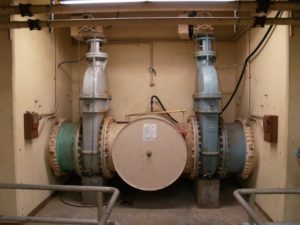
In addition to the rehabilitation or replacement of the Belmont, Redwood City, and Menlo Park pump stations, two other pump stations, one serving San Carlos and one boosting pressures for West Bay Sanitary District (WBSD), will be decommissioned. The Belmont force main and the 54-inch force main between Belmont Pump Station (BPS) and San Carlos Pump Station (SCPS) will be rehabilitated into a single Belmont force main conveying flow from the BPS to the drop structure-tunnel connection near SCPS. The flow will pass through new piping installed in the SCPS structure, but that pump station itself will be decommissioned as part of RESCU.
The existing SVCW conveyance system components are beyond their useful life. RESCU is necessary to eliminate ongoing reliability concerns and to accommodate changes in wastewater flowrates. Since the inception of the SVCW Capital Improvement Program in 2008, replacement of the conveyance system has been SVCW’s highest priority due to its age and the need for extensive and costly repairs, which involve significant commitments of maintenance staff time.
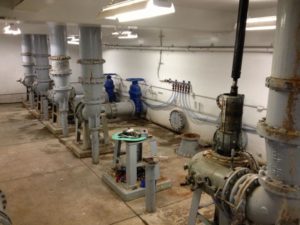
The pump stations are in varying condition, ranging from poor to very poor. Despite frequent maintenance, the pump stations need rehabilitation or replacement to provide safe and reliable operation and to accommodate the projected future flows through the conveyance system. Each pump station is at least 35 to 46 years old, well beyond their useful life for the mechanical and electrical components and approaching their useful lives for the structures. In all instances, the condition of the equipment has degraded to the extent that the systems require extensive maintenance to ensure functionality and reliability.
SVCW issued requests for qualifications in the last half of 2018 to teams that would design and build the pump station and force main project under a Progressive Design-Build procurement method. Four major design builders submitted for the project, and, at its February 2019 meeting, the SVCW Commission approved the Shea/Parsons Join Venture (SPJV) as the team to complete the design, construction, and commissioning of the PSI project. Construction of the PSI project will occur between 2020-2023.
Menlo Park Pump Station Improvements
The Menlo Park Pump Station (MPPS) is an existing pump station that will be rehabilitated to replace equipment that is at the end of its useful life and to accommodate changes in the overall SVCW conveyance system. The pump station is located at 1401 Marsh Road on the northeast corner of the intersection of Haven Avenue and Marsh Road within the city of Menlo Park. It is the furthest remote pump station in the SVCW conveyance system.
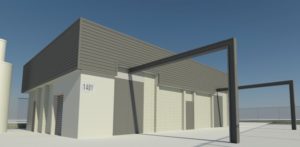
The pump station serves the WBSD collection system, which serves Menlo Park, Atherton, Portola Valley, and areas of Woodside, East Palo Alto, Woodside and unincorporated San Mateo and Santa Clara counties. Vehicle access to the site is from a gate on the entrance road leading to Bedwell Bayfront Park. All proposed improvements to the MPPS will be within the existing site, and mostly within the existing pump station building.
The Menlo Park pump station was designed in the late 1970’s, constructed in 1980, and electrical and controls systems were rehabilitated in 1990; these systems are now at the end of their useful lives. The existing MPPS is an integral part of SVCW’s conveyance system and is at the end of its useful life.
The existing pump station flow entry conditions pose hydraulic restrictions that create issues with handling incoming flows. To address constrictions, the inlet structure and wet well will be modified to improve hydraulic conditions. Modifications to the pump discharge manifold are also included in the project and all pumps will be replaced to handle higher flows. Additional improvements include new flow metering, vacuum valves, a new standby generator, electrical and HVAC improvements, flood protection and onsite storm water management improvements, seismic upgrades, and security fencing and lighting.
The objectives of the PSI project at the MPPS are to:
- Provide for a rehabilitated pump station facility suitable for current and future conditions and reduced staff operations.
- Provide pumping capacity to handle projected future flows estimated for the year 2040, which will exceed the capacity of the existing pump station.
- Provide for operability, monitoring, and maintainability improvements necessary for the most remote pump station in the SVCW conveyance system.
Redwood City Pump Station Improvements
The Redwood City Pump Station (RCPS) will be a new pump station to replace the existing one at 1581 Maple Street, adjacent to U.S. Highway 101 and behind (north and west of) the Redwood City Police Station. Construction of the new facility will begin in 2020.
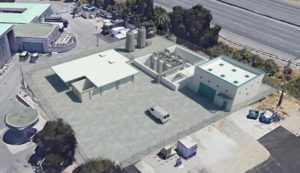
The existing RCPS is an integral part of SVCW’s conveyance system. Several alternative design concepts are being considered. One design concept that looks promising will allow the existing pump station to remain in operation on the site until a new structure is constructed adjacent and to the west of the existing RCPS building. Current design concepts include two new wet wells that serve both dry weather and wet weather pumps. The project also will include coarse screening of the wastewater flow entering the pump station. Coarse screens can remove large solids, rags and debris that are contributed by the jail facilities upstream, thereby protecting the new RCPS pumps from clogging.
Additional above-grade improvements include surge control tanks, a screenings handling building, odor control chemical storage tank, a fuel tank for the standby power generator, an electrical room, various improvements for flood protection and onsite storm water management, seismic upgrades, and security fencing and lighting.
The new RCPS will be capable of pumping flows from the Redwood City collection system and will be designed to boost the wet weather flows coming from the Menlo Park Pump Station. The RCPS will pump all flows through the section of force main that extends to the northern end of Inner Bair Island, where the flows will enter the new gravity pipeline inlet for transport to the SVCW treatment plant at the eastern end of Redwood Shores.
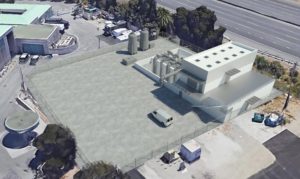
The objectives of the PSI Project at the RCPS are to:
- Provide for a new pump station facility suitable for current and future conditions and reduced staff operations. Currently, RCPS requires frequent hands-on maintenance and poses ongoing operational challenges.
- Provide adequate access to the pump station site, which can be limited or non-existent when storms or king tides flood the Maple Street entrance.
- Provide pumping capacity to handle projected future flows estimated for the year 2040, which will exceed the capacity of the existing pump station.
- Provide the ability to pump flows from the Menlo Park Pump Station during wet weather flows. Currently, flows from MPPS are conveyed by a 33-inch force main into a larger combined force main downstream of RCPS, and subsequently to SVCW’s treatment plant. With flows increasing in the future, the force main between Menlo Park and Redwood City would require rehabilitation and possible construction of a new pump station at Menlo Park to reliably convey flow to the gravity pipeline inlet structure on Inner Bair Island. By designing the RCPS to boost flows from WBSD during high flow wet weather events, the pressure within the 33-inch force main from MPPS to RCPS will be reduced, postponing into the future the need to rehabilitate the 33-inch force main pipe. Delaying the rehabilitation of the 33-inch force main helps SVCW manage the overall cost of the RESCU program.
Belmont Improvements
The Belmont elements of the PSI project consist of three components:
- The Belmont force main rehabilitation includes lining the existing force main sections that convey wastewater from Belmont to the San Carlos Pump Station (SCPS) location for discharge into the gravity pipeline.
- The Belmont Pump Station (BPS) will be rehabilitated with seismic upgrades, replacement pumps with the capacity to handle future flows, and upgrades to piping and the electrical system.
- San Carlos Pump Station will be decommissioned and repurposed to house ancillary equipment needed by the RESCU program. Improvements that will allow for that change include the installation of piping and the ability to meter and sample the combined flows being sent from the two cities (Belmont and San Carlos) into the gravity pipeline.
Belmont Force Main Rehabilitation
The Belmont force main rehabilitation will change how wastewater from Belmont enters the SVCW conveyance system. Currently, flows from Belmont enter the existing force main downstream of the SCPS. This will be changed to enable flows to enter the gravity pipeline at the SCPS. The rehabilitation work will include the following components: rehabilitation of an existing 1,150-foot, 24-inch diameter segment of the force main; and insertion of a slipline* into 3,550 feet of the existing 54-inch diameter force main to transport the Belmont flow to the new gravity pipeline drop structure connection at the SCPS. The work will be conducted within existing rights-of-way on Shoreway Road and Skyway Road, as well as within the California Department of Transportation’s (Caltrans) rights-of-way at the Holly Street and U.S. 101 interchange. These physical and operational changes are needed for the Belmont system to deliver flows to the new SVCW gravity pipeline.
*Sliplining is a trenchless construction method that involves inserting a new liner pipeline within the existing pipeline. This technique allows for pipe rehabilitation without the need for excavating a trench along the full length of the rehabilitated pipe.
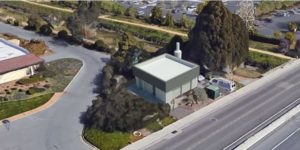
Belmont Pump Station Rehabilitation
The BPS is located on a 0.06-acre site at 1385 Shoreway Road in Belmont. The BPS portion of the PSI project includes renovations to the pump station building and installation of three new pumps, replacing the existing pumps. In addition, all electrical components, and all site security within the BPS, will be upgraded to SVCW standards current at the time of construction. Most of the pump station rehabilitation and replacement is expected to occur within the existing building.
San Carlos Pump Station Improvements
The improvements at the SCPS, which is located on the northease end of Monte Vista Drive, include extending both the San Carlos sanitary sewer and the Belmont force main to allow wastewater flows from both cities to connect to the gravity pipeline. Also included will be the relocation of an existing 10-inch San Carlos force main. A different RESCU project will complete the installation of flow metering and sampling of the combined Belmont and San Carlos wastewater flows, in addition to the drop structure that will connect the combined flows to the gravity pipeline.
The objectives of the Belmont elements of the PSI project are to:
- Provide for a rehabilitated BPS facility suitable for future conditions and reduced staff operations. Currently, BPS requires frequent hands-on maintenance, and there are several ongoing operational challenges with the pump station in its current configuration.
- Provide pumping capacity to handle projected future flows estimated for the year 2040, which will exceed the capacity of the existing pump station.
- Improve the condition of the existing 24-inch and 54-inch force mains, which will be the main conveyance piping to transport Belmont flows to the connection with the gravity pipeline.
Task Orders Approved for Five Firms in Support of PSI
In addition to approving a design-build agreement for Pump Stations Improvements (PSI) with Shea/Parsons Joint Venture, the SVCW Commission approved task orders for five firms that collectively constitute SVCW’s project team.
Together, the authorizations for the five firms round out the requirements for the PSI Stage 1 work over the next 11 months. These include:
- Brown and Caldwell services as Owner’s Engineering Advisor will include assisting SVCW staff with the technical detail coordination involved in the Stage 1 work, review of project design as it progresses, and preparation of an independent cost estimate for Stage 2. Brown and Caldwell will also provide input as the Stage 2 Design-Build amendment is negotiated. Brown and Caldwell prepared the 20% design, performed hydraulic modeling, and established the design criteria that will be used in the project.
- Freyer & Laureta Stage 1 scope will be to assist SVCW staff in tasks specifically related to site civil work including topographical surveys, soils composition analysis, site grading and paving, and storm water management. Freyer & Laureta provided preliminary site civil details included in the 20% design.
- Cascade Integration and Development (CID) is SVCW’s preferred SCADA (Supervisory Control and Data Acquisition) integrator who will assist with facility automation design services during Stage 1. Their services include electrical and instrumentation design reviews and design progression of the project’s SCADA and automation system. CID has performed these tasks on SVCW’s design-build and design-bid-build projects for many years and is fully versed in the requirements to ensure seamless communication between all of SVCW’s facilities.
- Tanner Pacific Construction Quality Assurance Stage 1 Services will include assisting the SVCW project team with document management, development of construction schedules and sequencing plans, review of plans for constructability, input on approaches to protect existing structures and facilities.
- Collaborative Strategies Consulting (CSC) has been performing project management services for the PSI project through the early project development phase and through the procurement phase. Moving forward, responsibilities as project manager will include strategic planning, oversight of the design-build entity and consultants, communication with SVCW staff and management, coordination with other RESCU projects, and overall responsibility for schedule and budget of the project. CSC has provided project management services successfully for SVCW for seven years, including the 48” Force Main Reliability Improvements Project.